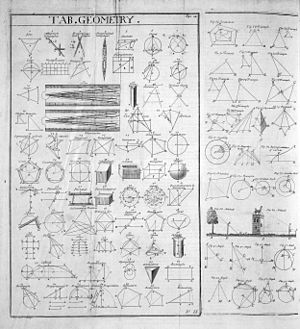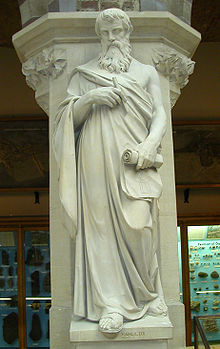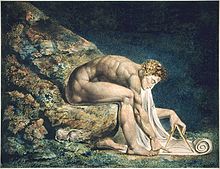History of geometry
Geometry (from the Ancient Greek: γεωμετρία; geo- "earth", -metron "measurement") arose as the field of knowledge dealing with spatial relationships.
His book, The Elements is widely considered the most influential textbook of all time, and was known to all educated people in the West until the middle of the 20th century.
Early geometry was a collection of empirically discovered principles concerning lengths, angles, areas, and volumes, which were developed to meet some practical need in surveying, construction, astronomy, and various crafts.
[14] "Since these tablets predate the Sulbasutras period by several centuries, taking into account the contextual appearance of some of the triples, it is reasonable to expect that similar understanding would have been there in India.
The occurrence of the triples in the Sulvasutras is comparable to mathematics that one may encounter in an introductory book on architecture or another similar applied area, and would not correspond directly to the overall knowledge on the topic at that time.
Since, unfortunately, no other contemporaneous sources have been found it may never be possible to settle this issue satisfactorily.Thales (635–543 BC) of Miletus (now in southwestern Turkey), was the first to whom deduction in mathematics is attributed.
The proofs of the impossibility of these constructions, finally achieved in the 19th century, led to important principles regarding the deep structure of the real number system.
Aristotle (384–322 BC), Plato's greatest pupil, wrote a treatise on methods of reasoning used in deductive proofs (see Logic) which was not substantially improved upon until the 19th century.
The Roman Republic and Empire that succeeded and absorbed the Greek city-states produced excellent engineers, but no mathematicians of note.
[18] Civil wars, decreasing investments in maintenance and acquisition of new scrolls and generally declining interest in non-religious pursuits likely contributed to a reduction in the body of material available in the Library, especially in the 4th century.
Chapter 12, containing 66 Sanskrit verses, was divided into two sections: "basic operations" (including cube roots, fractions, ratio and proportion, and barter) and "practical mathematics" (including mixture, mathematical series, plane figures, stacking bricks, sawing of timber, and piling of grain).
With the sides of the cyclic quadrilateral being a, b, c, and d, the radius R of the circumscribed circle is: The first definitive work (or at least oldest existent) on geometry in China was the Mo Jing, the Mohist canon of the early philosopher Mozi (470–390 BC).
The Mo Jing described various aspects of many fields associated with physical science, and provided a small wealth of information on mathematics as well.
"[24] Similar to the atomists of Democritus, the Mo Jing stated that a point is the smallest unit, and cannot be cut in half, since 'nothing' cannot be halved.
One of the oldest Chinese mathematical texts to present geometric progressions was the Suàn shù shū of 186 BC, during the Western Han era.
[30] In comparison to later works, the formula for pi given by the French mathematician Franciscus Vieta (1540–1603) fell halfway between Zu's approximations.
The Nine Chapters on the Mathematical Art, the title of which first appeared by 179 AD on a bronze inscription, was edited and commented on by the 3rd century mathematician Liu Hui from the Kingdom of Cao Wei.
This was more accurate than Liu Hui's contemporary Wang Fan, a mathematician and astronomer from Eastern Wu, would render pi as 3.1555 by using 142⁄45.
[33] Liu Hui also wrote of mathematical surveying to calculate distance measurements of depth, height, width, and surface area.
Continuing the geometrical legacy of ancient China, there were many later figures to come, including the famed astronomer and mathematician Shen Kuo (1031–1095 CE), Yang Hui (1238–1298) who discovered Pascal's Triangle, Xu Guangqi (1562–1633), and many others.
A copy of Ptolemy's Almagest was brought back to Sicily by Henry Aristippus (d. 1162), as a gift from the Emperor to King William I (r. 1154–1166).
An anonymous student at Salerno travelled to Sicily and translated the Almagest as well as several works by Euclid from Greek to Latin.
[41] In c. 1413 Filippo Brunelleschi demonstrated the geometrical method of perspective, used today by artists, by painting the outlines of various Florentine buildings onto a mirror.
Decades later, his friend Leon Battista Alberti wrote De pictura (1435/1436), a treatise on proper methods of showing distance in painting based on Euclidean geometry.
Della Francesca also started the now common practice of using illustrated figures to explain the mathematical concepts, making his treatise easier to understand than Alberti's.
Jan van Eyck, among others, was unable to create a consistent structure for the converging lines in paintings, as in London's The Arnolfini Portrait, because he was unaware of the theoretical breakthrough just then occurring in Italy.
The culmination of these Renaissance traditions finds its ultimate synthesis in the research of the architect, geometer, and optician Girard Desargues on perspective, optics and projective geometry.
The drawing is based on the correlations of ideal human proportions with geometry described by the ancient Roman architect Vitruvius in Book III of his treatise De Architectura.
Beginning not long after Euclid, many attempted demonstrations were given, but all were later found to be faulty, through allowing into the reasoning some principle which itself had not been proved from the first four postulates.
Developments in algebraic geometry included the study of curves and surfaces over finite fields as demonstrated by the works of among others André Weil, Alexander Grothendieck, and Jean-Pierre Serre as well as over the real or complex numbers.











